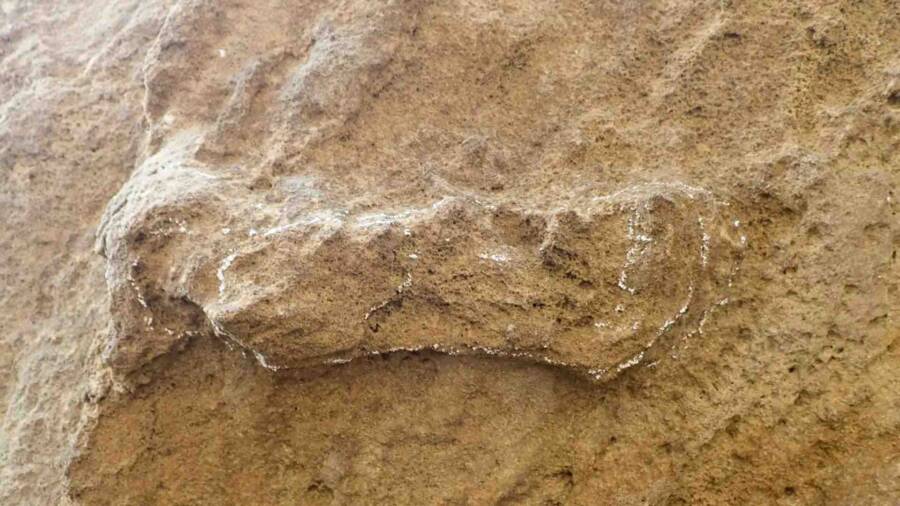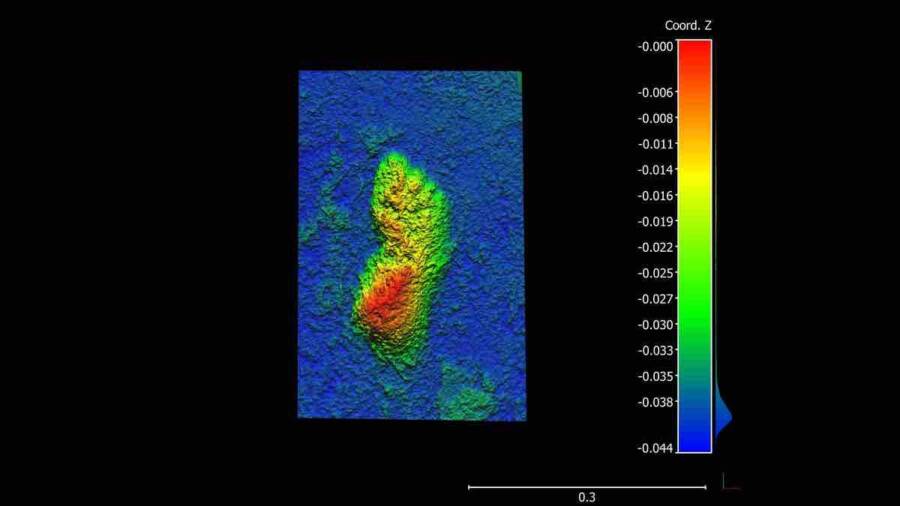The tracks, which were discovered near the southern tip of the African continent, are approximately 153,000 years old.

Charles HelmThe prehistoric human footprint found in South Africa, outlined in chalk.
Archaeologists in South Africa have discovered the oldest known footprints attributed to Homo sapiens, thanks to a modern form of dating known as optically-stimulated luminescence (OSL). Incredibly, the footprints in question date back a whopping 153,000 years.
The researchers’ findings were published in the journal Ichnos, in which they explained how they used this dating method to trace the origins of prints found at multiple “ichnosites” — archaeological sites with tracks left by early humans — near the southern tip of the African continent.
Imprints found at these ichnosites were varied. Four of the sites revealed hominin tracks, one featured knee impressions, and four had “ammoglyphs” — a general term representing any preserved pattern made by humans.
Not long ago, finding human tracks dating back more than 50,000 years was extremely rare, but as time has gone on, extensive research and analysis has revealed prints that are far older. Still, study lead author Charles Helm told Live Science that he and his colleagues were “pleasantly astonished” when they identified one track site dating back 153,000 years.
Most of the other samples that they examined dated to between 70,000 and 130,000 years ago, Helm, a research associate at the African Centre for Coastal Palaeoscience at Nelson Mandela University, said.
To explain how Helm and his team determined the date of these ancient footprints, OSL works by analyzing grains of quartz or feldspar near the fossilized tracks. Researchers can use this data to then estimate how much time has passed since those grains were last exposed to sunlight.
If surfaces coated with prehistoric human tracks were quickly covered over, then the quartz or feldspar grains around them would have been too. By determining when these grains were buried, researchers can get a decent estimate of when the footprints were created.
In this instance, the Homo sapiens tracks were left on wet sand, and then quickly covered as dry sand was carried by the wind.
While OSL can’t trace the footprints to the exact year of their creation, it can give researchers a “reasonably confident” estimate.

Charles HelmA 3D photogrammetry image of another prehistoric human footprint dating back around 80,000 years.
In any case, this discovery marks the identification of the oldest known Homo sapiens footprints. While older, preserved hominin tracks have been found throughout Africa, they cannot be attributed to Homo sapiens, which evolved in the continent approximately 300,000 years ago.
As Helm and his study co-author Andrew Carr explained to The Conversation, the discovery of these ancient footprints “are a useful way to complement and enhance our understanding of ancient hominins in Africa.”
Relatively few hominin bones have been discovered near the Cape coast, where the ancient footprints were found, which often leads researchers to look elsewhere when tracing the movement of humanity throughout Africa. However, these tracks as well as other evidence from the time period, including stone tools, art, and jewelry, indicate that ancient humans lived and thrived along the Cape coast before spreading out to other places.
As the researchers wrote in the study, these tracks “can provide not just an indication of humans travelling across these surfaces as individuals or groups, but also evidence of some of the activities that they engaged in.”
The Cape coast is also particularly well-suited to OSL analysis, given that it is high in quartz, which provides significant luminescence. The abundant sunshine, winds, and wide beaches also mean that any “pre-existing luminescence signals are fully removed prior to the burial event of interest,” allowing researchers to get a more accurate age estimate.
As Helm told Live Science, this discovery has “acted as a spur to continue our search for hominin tracks in deposits we know are even older.”
That said, the researchers also worry that time is running out for studying these sites. The plentiful sand and winds in the region are both a boon and a curse for research as ancient hominin tracks were well-preserved as a result, but these regions are also known for being highly vulnerable to erosion.
“We often have to work fast to record and analyze them before they are destroyed by the ocean and the wind,” they wrote.
Still, Helm and his colleagues are confident that additional hominin ichnosites are waiting to be found near the South African coastline. They would also like to expand this research, focusing on older sites in the region dating from 400,000 years to 2 million years ago to see what they find.
After reading about this new discovery, learn about another recent study that uncovered new groups of prehistoric humans in Europe. Or, read all about Neanderthals, the ancient hominins that went extinct 40,000 years ago.





